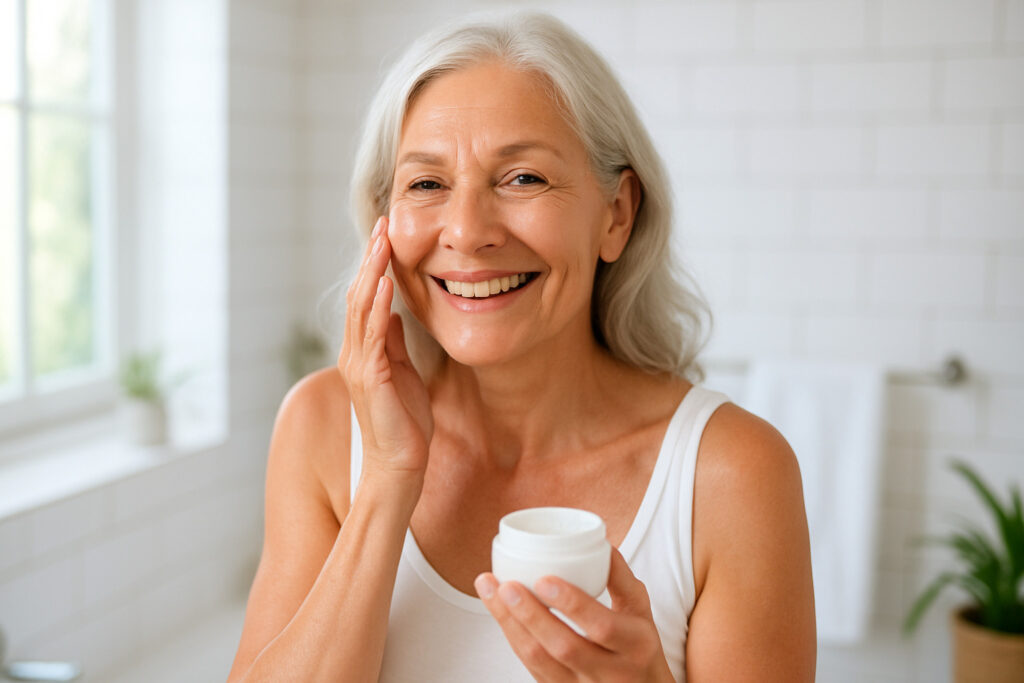Why Effective Beauty Tips for Aging Skin Can Transform Your Confidence
Beauty tips for aging skin aren’t about chasing impossible youth – they’re about supporting your skin’s natural evolution while maintaining that healthy glow you love. As we age, our skin undergoes significant changes: collagen production slows by about 1% per year after age 25, cell turnover decreases, and our protective barrier becomes more delicate.
Quick Beauty Tips for Aging Skin:
- Daily sunscreen (SPF 30+) prevents 80% of visible aging
- Gentle cleansing twice daily preserves your skin barrier
- Retinol or bakuchiol at night boosts cell renewal
- Vitamin C serum in the morning fights free radicals
- Rich moisturizer with ceramides locks in hydration
- Chemical exfoliation weekly removes dead skin buildup
- Eye cream targets delicate under-eye area
- Neck and hand care prevents these telltale aging zones
The good news? Up to 90% of visible skin aging comes from sun exposure (photoaging) rather than natural aging – meaning much of what we see is actually preventable and even reversible with the right approach.
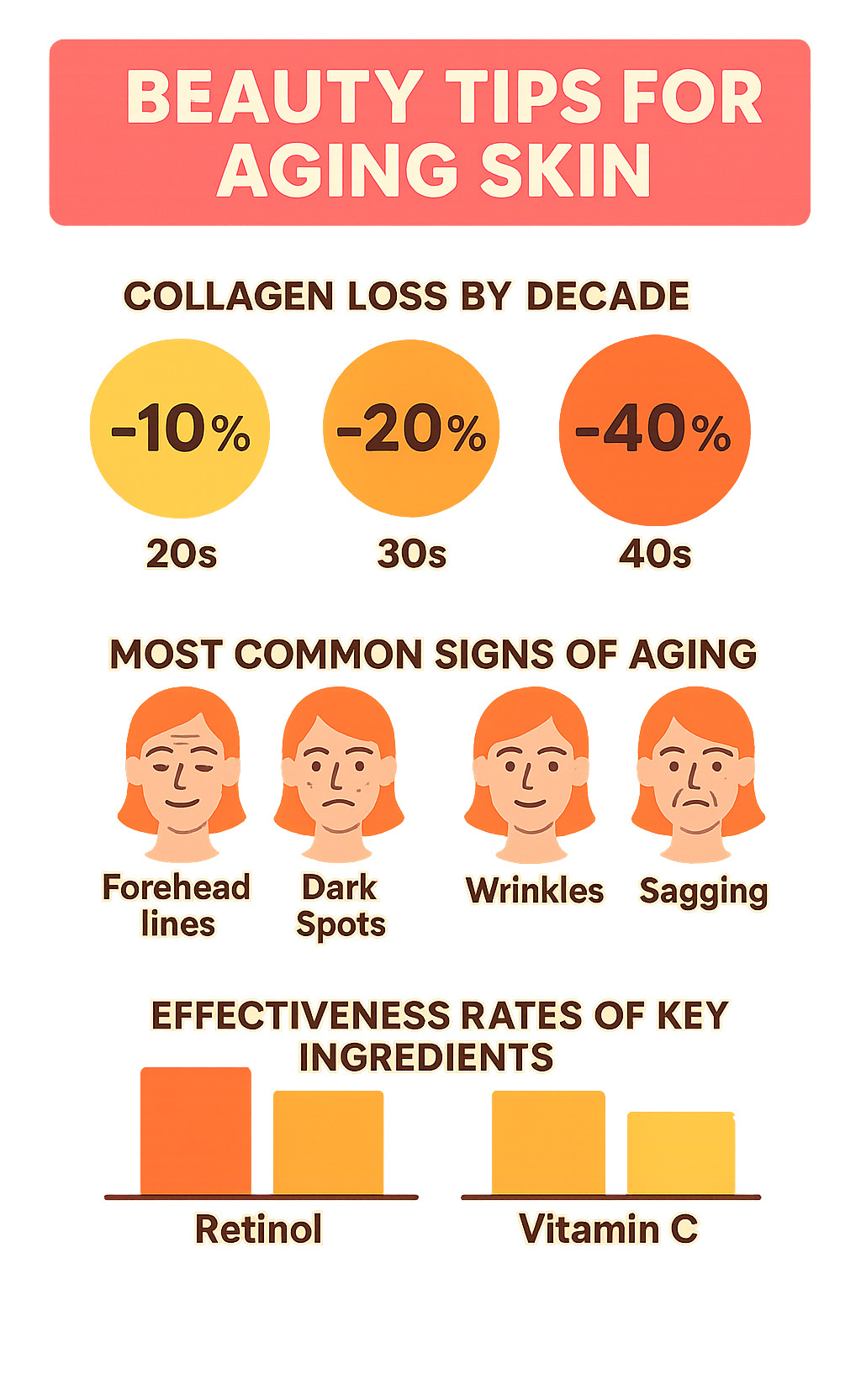
Quick Beauty tips for aging skin definitions:
– Beauty and self-care
– Sustainable beauty products
– Beauty hacks for busy women
How Your Skin Evolves Over the Decades
Think of your skin as a beautifully aging wine – it’s not getting worse, it’s just changing its character. Understanding these changes is like having a roadmap for the best beauty tips for aging skin that actually work with your skin’s natural evolution.
Your skin tells a story decade by decade. In your twenties, that thinner epidermis starts subtly appearing. By your thirties and forties, the slower renewal process becomes more obvious – where your skin once refreshed itself every 28 days, it now takes 35 to 45 days.
Here’s what’s happening: your sebaceous glands are gradually producing decreased sebum, while your body’s collagen decline accelerates to about 1% per year after age 25. This is completely normal and manageable.
The real game-changer is knowing the difference between intrinsic vs extrinsic aging. Intrinsic aging is your genetic blueprint. Extrinsic aging comes from environmental damage, with photoaging being the biggest culprit.
Here’s the encouraging news: up to 80% of what we see as “aging” is actually preventable sun damage. This means the right beauty tips for aging skin can dramatically improve how your skin looks and feels.
For more detailed information, check out this Scientific research on skin aging.
The Most Common Signs to Watch
Wrinkles typically appear around areas where you express emotions most – laugh lines and concentration furrows. These start as temporary creases but gradually become permanent.
Age spots are like little time stamps from sun exposure. These flat, brown patches usually show up after age 40 on your face, hands, shoulders, and arms.
Dryness becomes more noticeable as your skin produces less natural oil. You might find your skin feeling tight after cleansing or looking dull and flaky.
Sagging happens gradually as gravity teams up with declining collagen and elastin. Your jawline isn’t as sharp, or cheeks seem to have shifted southward.
Broken capillaries appear as tiny red lines, especially around your nose and cheeks, because aging skin becomes thinner and more transparent.
Beauty Tips for Aging Skin: Your Daily Routine Blueprint
Building a skincare routine for aging skin doesn’t have to feel overwhelming. The most effective beauty tips for aging skin focus on consistency over complexity.
Your morning routine is about protection and preparation. Your evening routine shifts to repair and renewal. This natural rhythm works with your skin’s own daily cycles.
Start with a gentle cleanser, moisturizer, and broad-spectrum SPF. Once these become second nature, add targeted treatments like vitamin C serums, retinol, and specialized eye creams.
Don’t forget your neck and hands – these areas show aging just as much as your face but often get neglected.
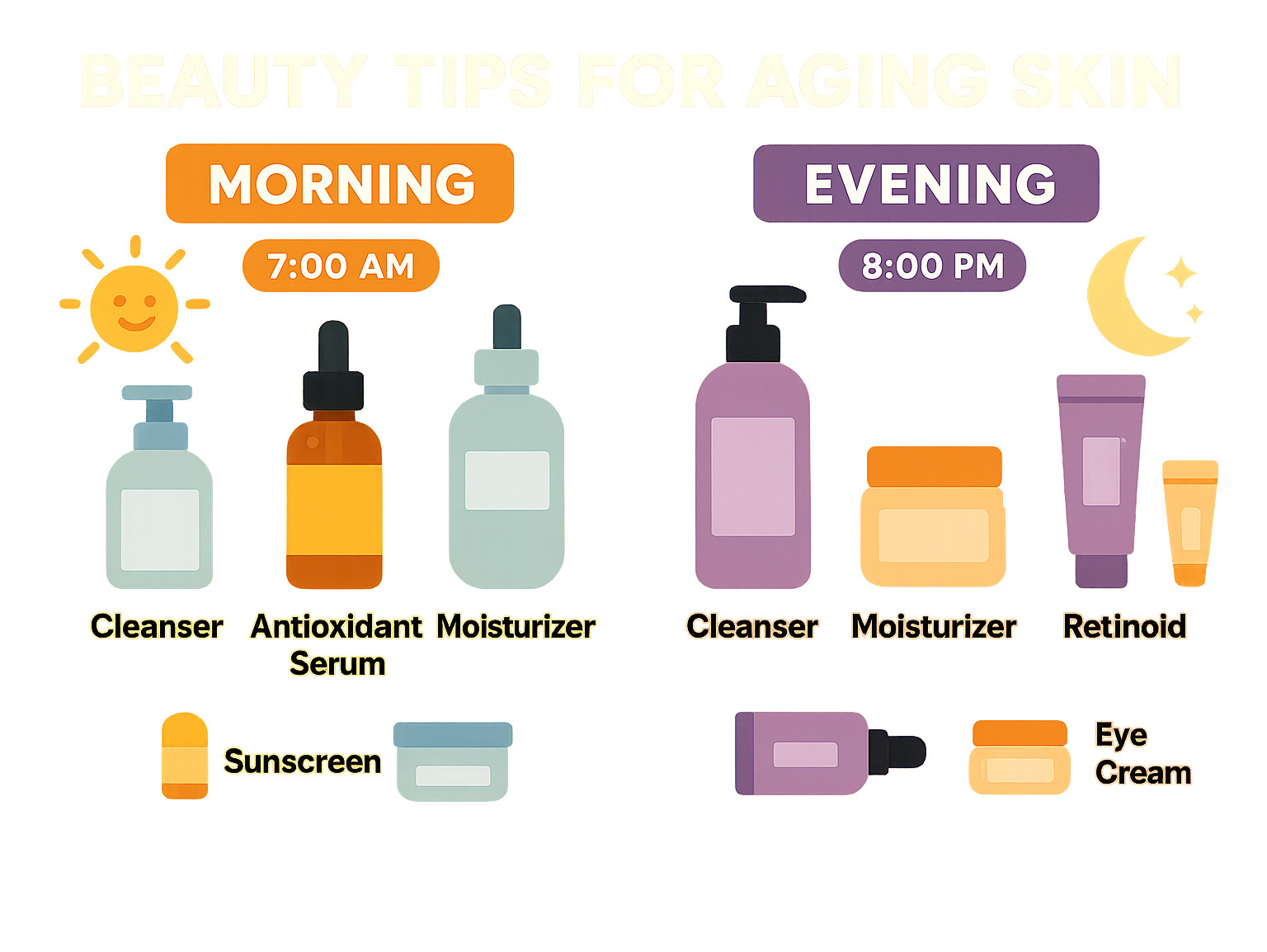
Morning Routine Essentials
Start with a gentle cleanser that removes overnight buildup without making your skin feel tight. Cream and lotion cleansers work best for dryness.
Next comes your antioxidant serum – vitamin C is the superstar here. Think of it as daily protection against free radicals from pollution and UV rays. Apply to slightly damp skin.
Your final step is sunscreen with SPF 30 or higher. This prevents up to 90% of visible aging – making it the best investment for your skin.
For sensitive skin options, check our guide to Top Anti-Aging Products for Sensitive Skin.
Night Routine Essentials
Evening is when your skin shifts into repair mode. Start with thorough cleansing – double cleansing works wonders if you wear makeup or sunscreen.
Retinol is the gold standard of anti-aging, reducing wrinkles and improving skin texture. Start slow – begin with low concentration every third night, gradually building up.
If retinol irritates your skin, bakuchiol offers similar benefits with less drama. This plant-derived ingredient improves firmness and reduces fine lines without irritation.
Finish with a rich night cream with ceramides and peptides to lock in hydration while you sleep.
For product recommendations, see our Best Night Creams for Dry, Aging Skin guide.
Customizing for Different Skin Types & Tones
Melanin-rich skin has natural aging advantages, but hyperpigmentation can be a concern. Focus on consistent sunscreen and gentle exfoliation. Vitamin C, niacinamide, and tranexamic acid are excellent for evening skin tone.
Sensitive skin requires patience. Introduce products one at a time, wait weeks between additions, and always patch test. Look for fragrance-free, hypoallergenic formulas.
Oily mature skin still needs moisture, but heavy creams might feel uncomfortable. Choose lightweight, non-comedogenic formulas and consider niacinamide for oil regulation.
For gentler retinol options, see our Retinol Alternatives for Sensitive Skin Types guide.
Power Ingredients That Really Work
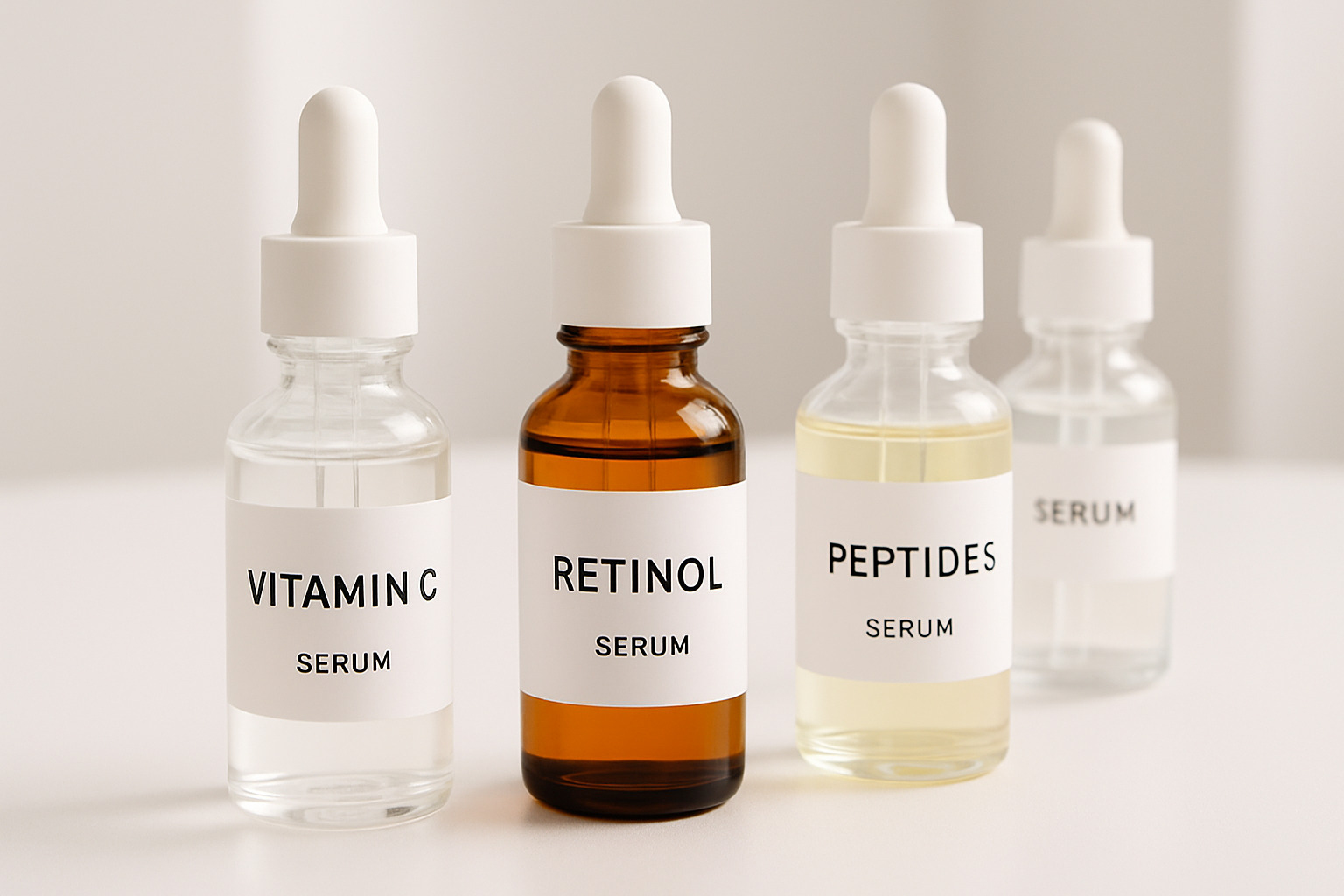
Knowing which ingredients actually deliver results can save you time, money, and frustration. After decades of research, certain ingredients have proven themselves as true anti-aging workhorses.
Retinoids are the undisputed champions. These vitamin A derivatives speed up cell turnover and boost collagen production, showing significant improvements in fine lines and skin texture.
Vitamin C acts as your skin’s daily bodyguard against environmental damage. This antioxidant protects against free radicals and helps produce more collagen.
Peptides are tiny messengers that tell your skin to act younger, signaling cells to ramp up collagen production and improve elasticity.
Niacinamide (vitamin B3) is a multitasking hero that controls oil, calms inflammation, and improves pores and uneven tone.
Hyaluronic acid holds up to 1,000 times its weight in water, instantly plumping fine lines and giving skin a dewy glow.
Ceramides keep your skin barrier strong and healthy, locking in moisture and protecting against environmental stressors.
Sunscreen filters are the most important anti-aging ingredient of all, providing broad-spectrum protection against aging UV rays.
| Retinol | Bakuchiol |
|---|---|
| Vitamin A derivative | Plant-derived from babchi |
| Can cause initial irritation | Gentler, less irritating |
| Use only at night | Can be used morning or night |
| Proven 40+ years of research | Newer, growing research base |
| May increase sun sensitivity | No increased photosensitivity |
| More dramatic results | Gradual, gentle improvements |
How to Layer Actives Without Irritation
Start with the “low and slow” approach. Introduce one new active at a time, beginning with the lowest concentration. Use every third night initially, gradually building up.
The sandwich method reduces irritation: apply moisturizer, then your active ingredient, followed by another moisturizer layer.
Always patch test new products behind your ear or on your inner wrist, waiting 24-48 hours to check for reactions.
Budget-Friendly Stars Under $30
Effective anti-aging doesn’t require a fortune. Many affordable brands use the same proven ingredients found in luxury lines.
Focus on simple, effective formulations with clear labeling showing exact concentrations. Sometimes a basic drugstore retinol outperforms expensive “anti-aging complexes.”
For top affordable picks, check our Anti-Aging Serums That Work (Under $30!) guide.
Lifestyle Habits to Boost Skin Longevity
The most effective beauty tips for aging skin actually happen away from your bathroom mirror. Your daily lifestyle choices create the foundation for healthy, resilient skin.
Hydration starts from within – that eight-glasses-a-day rule really matters. Well-hydrated skin appears plumper and more radiant, while dehydrated skin makes every fine line look deeper.
Your balanced diet acts like internal skincare. Antioxidant-rich foods like berries and leafy greens fight free radicals. Omega-3 fatty acids from fish and nuts keep your skin barrier strong. Lean proteins provide amino acids for collagen building.
Quality sleep is when your skin does its most important repair work. During 7-9 hours, your body produces growth hormone that rebuilds collagen and repairs daily damage.
Regular exercise boosts circulation, delivering oxygen and nutrients while flushing out toxins. Just cleanse promptly after working out to prevent pore blockage.
Stress management deserves attention because chronic stress literally ages skin faster through excess cortisol production, which breaks down collagen.
Avoiding smoking is non-negotiable – tobacco restricts blood flow, depleting skin of oxygen and nutrients.
Limiting alcohol prevents dehydration and inflammation that accelerate aging.
For detailed information about diet’s impact on aging, see this Scientific research on diet & aging.
Sun Protection 24/7
Daily sun protection prevents up to 90% of visible aging – more powerful than any serum or cream.
UV rays penetrate windows, bounce off surfaces, and damage skin even on cloudy days. Your protection strategy needs to be comprehensive.
UPF-rated clothing offers reliable protection for your décolletage and arms. Wide-brimmed hats protect face, ears, and neck. UV-blocking sunglasses prevent squinting while protecting delicate eye area.
The shade rule: when your shadow is shorter than you are (10 AM-4 PM), UV rays are strongest.
Self-tanner gives you that healthy glow without UV damage – a win-win for maintaining color while protecting your skin’s future.
For comprehensive strategies, refer to this Scientific research on sun protection.
Targeted Fixes: Age Spots, Wrinkles & Undereye Bags
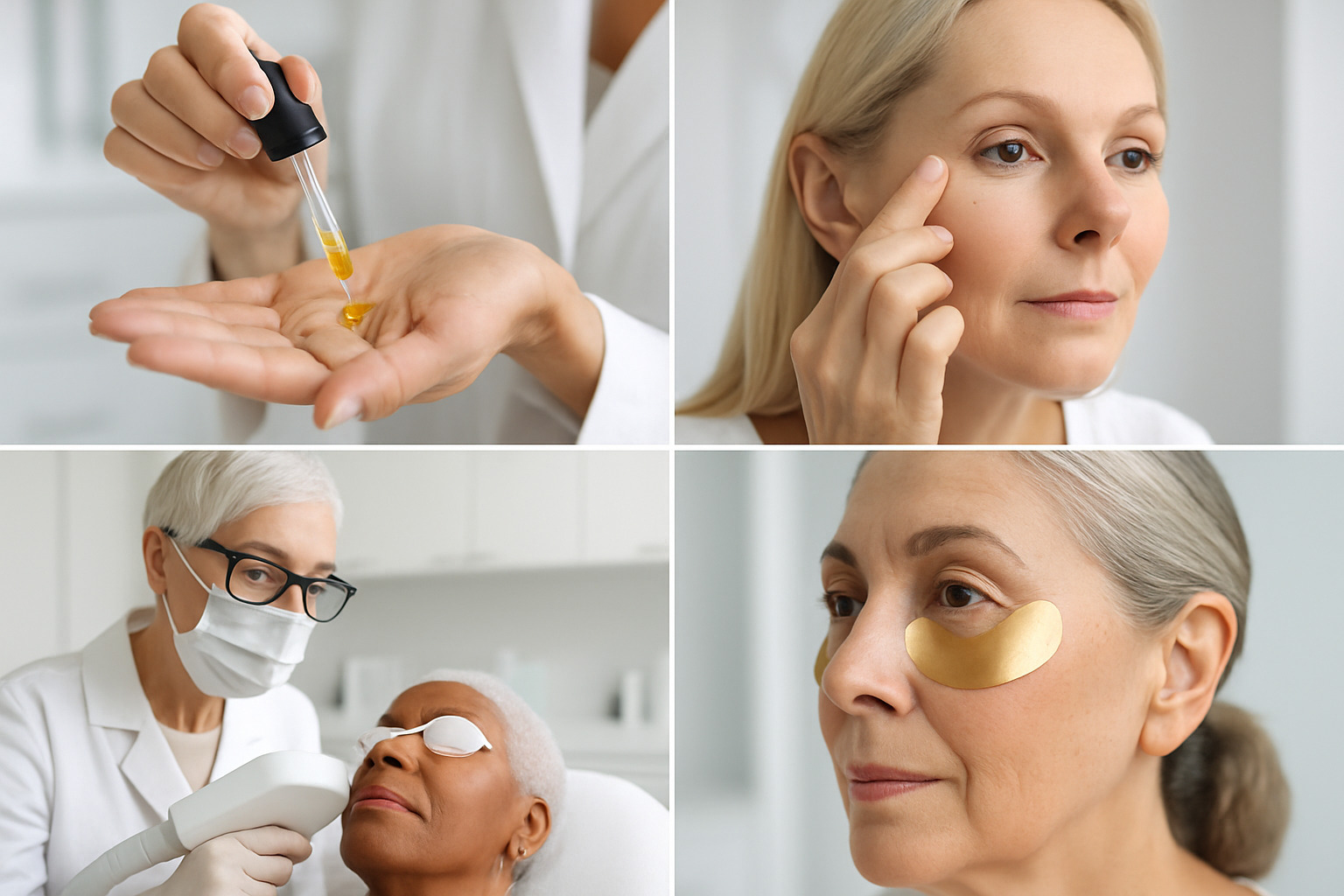
Tackling specific aging concerns requires a focused approach. Many issues can be significantly improved with the right combination of ingredients and techniques.
Age spots and hyperpigmentation respond to consistent brightening treatments. Vitamin C fades dark spots over time, while tranexamic acid offers gentle results for sensitive skin. The key is patience – topical treatments typically take 8-12 weeks to show results.
For stubborn spots, chemical peels performed by professionals can accelerate the process by removing damaged surface layers.
Wrinkles and fine lines have their own treatment hierarchy. Surface-level lines improve with consistent retinoid use and proper hydration. For deeper expression lines, professional treatments like neuromodulators (Botox) provide remarkable results. Dermal fillers work by plumping areas where volume has been lost.
Under-eye bags and puffiness make you look tired even when well-rested. Caffeine-containing eye creams provide temporary tightening by constricting blood vessels. Apply gently with your ring finger using light tapping motions.
Cold compresses work wonders for morning puffiness – keep spoons in the freezer overnight and press gently under eyes for instant depuffing.
Sleeping with your head slightly lifted prevents fluid from pooling under your eyes overnight.
For gentler approaches, see our Natural Anti-Aging Solutions guide.
Microneedling has gained popularity as a middle-ground treatment, creating tiny channels that encourage collagen production and improve product absorption.
When to See a Dermatologist
Persistent changes that don’t improve after 3-6 months of dedicated skincare deserve professional evaluation.
Any new or changing moles, unusual growths, or skin lesions should be examined promptly. Regular skin cancer screenings become increasingly important as cumulative sun exposure increases risk over time.
Professional evaluation is valuable when you’re ready to explore treatments beyond topical products. A qualified dermatologist can assess your concerns and recommend appropriate treatments.
Find a board-certified dermatologist at Find a dermatologist.
Professional Treatments & Their Pros and Cons
When at-home beauty tips for aging skin reach their limits, professional treatments offer more dramatic improvements but come with higher costs, potential downtime, and increased risks.
Laser treatments address specific concerns like age spots, broken capillaries, or uneven texture. Most require multiple sessions with potential redness, swelling, or peeling afterward.
Radiofrequency treatments heat deeper skin layers to stimulate collagen production with minimal downtime. Results develop gradually over months, requiring a series of treatments.
Chemical peels remove damaged skin layers for a “fresh start.” Light peels cause slight redness for days, while deeper peels require weeks of recovery with significant peeling.
Injectable treatments offer immediate results. Neuromodulators relax expression-line muscles, while dermal fillers restore lost volume. Results are visible within days to weeks but require maintenance.
Safe Treatment Checklist
Verify provider credentials thoroughly. Look for board-certified dermatologists or plastic surgeons with specific training in your desired procedures.
Visit the clinic beforehand to assess cleanliness and professionalism. Reputable facilities maintain sterile conditions and have emergency protocols.
Set realistic expectations through honest conversations about what treatments can achieve. Good providers never promise unrealistic results or pressure you into extensive treatments.
Frequently Asked Questions about Beauty Tips for Aging Skin
How early should I start an anti-aging routine?
The best time to start was yesterday, but the second-best time is today. Begin basic prevention in your mid-to-late twenties with gentle cleansing, daily moisturizing, and religious sunscreen use.
More targeted treatments like retinoids can wait until your thirties or whenever you first notice lines that don’t disappear when you stop smiling.
Can I reverse sun damage at 50+?
Yes, you absolutely can improve sun damage at any age! While we can’t completely erase decades of sun exposure, your skin has amazing repair ability when given the right tools.
Consistent use of retinoids, vitamin C, and gentle chemical exfoliants can dramatically improve skin texture, fade age spots, and smooth fine lines. Many people see noticeable improvements within 3-6 months.
Which is better: retinol or peptides if my skin is sensitive?
For sensitive skin, peptides are the gentler choice while still delivering real anti-aging benefits. They signal your skin to produce more collagen without potential retinoid irritation.
If you want to try retinol, start with the lowest concentration, use the sandwich method with moisturizer, and introduce it just once weekly.
Bakuchiol deserves mention as nature’s answer to retinol – offering similar benefits without irritation, perfect for sensitive skin types.
Conclusion
At Beyond Beauty Lab, we’ve learned that the most successful beauty tips for aging skin aren’t about fighting time – they’re about working with your skin as it naturally evolves.
The journey through this guide reveals a simple truth: effective beauty tips for aging skin come down to key habits anyone can master. Daily sunscreen prevents 80% of visible aging. Gentle cleansing respects your changing skin barrier. Targeted treatments like retinoids or vitamin C work quietly to renew and protect.
You don’t need to overhaul your entire life overnight. Start with one or two manageable changes. Maybe it’s switching to a gentler cleanser or committing to daily sunscreen. Your skin will thank you for small, consistent steps more than dramatic gestures you can’t maintain.
Most anti-aging ingredients need 3-6 months to show their full potential. This isn’t a sprint – it’s a marathon of self-care that gets easier as it becomes second nature.
The beauty of aging skin isn’t just about looking good. It’s about feeling confident in your own skin, literally and figuratively. When you take care of yourself consistently, that confidence radiates outward in ways no cream or serum ever could.
For those ready to dive deeper into age-specific care, our comprehensive guide to skincare tips for glowing skin in your 40s offers even more targeted advice.
Your skin tells the story of a life well-lived. With the right beauty tips for aging skin, you can help that story continue beautifully for years to come.

